Can't Beat This
Cookbooks Do Things the Digital Food World Can't
Pity the poor cookbook author these days. Bloggers rampantly reprint their recipes without permission or tweak them with some minor changes and call them their own; mobile devices allow shoppers to scroll through multiple recipes at the grocery store or in front of their fridge; and quality recipes magically appear with a simple Internet query—“what can I make with an onion, some pasta, and a bunch of parsley?”
But hold the tea and sympathy and pass the home-baked crumpets, because home cooks are still gobbling up books about food and cooking. Today’s cookbooks abound with beautiful design and many more color photos than in years past. This sensual appeal and the exploration of unusual cuisines and haute restaurant ingredients have kept cookbook sales brisk. Here are a few of the most vibrant new titles that are as tempting to look at as they are to cook from.
Summer Cocktails
Margaritas, Mint Juleps, Punches, Party Snacks, and More
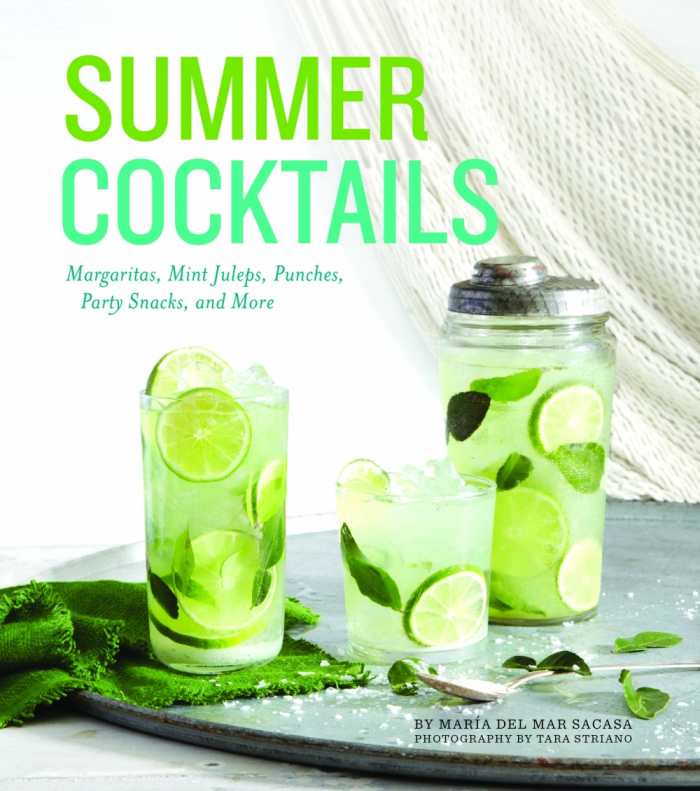
Maria del Mar Sacasa
Quirk Books
Hardcover $22.95 (158pp)
978-1-59474-785-4
Buy: Amazon
Leave it to Quirk Books to open a cocktail book with a recipe for preparing bacon. The playfulness continues throughout Summer Cocktails with scores of tempting drink recipes, remedies in the case of overindulgence (Antidotes), snacks to accompany potent potables, and a detailed section about making homemade syrups, infused liquors, and sour mixes.
The main focus, of course, is the cocktail recipes. Del Mar Sacasa offers a bounty of classics, lightened up for warm weather imbibing, as well as some “novel potions that flirt with the old guard,” like the Flavor Flav, a martini frisked up with shiso and Shishito peppers; and the Honey Badger, a sassy concoction of bourbon, chile-spiced honey syrup, lemon juice, and sparkling wine. Many cocktails reflect the author’s Latin American heritage and feature such zesty flavors as tamarind, cilantro, mango, and jalapeño.
Airy photos of rainbow-colored drinks in icy, sweating glasses and fun snacks for entertaining make this an alluring package, whether you are planning to be the mixologist at your next poolside party or just want to laze about in a hammock staying hydrated in style.
RACHEL JAGARESKI (May 27, 2015)
The Waste Not, Want Not Cookbook
Save Food, Save Money, and Save the Planet
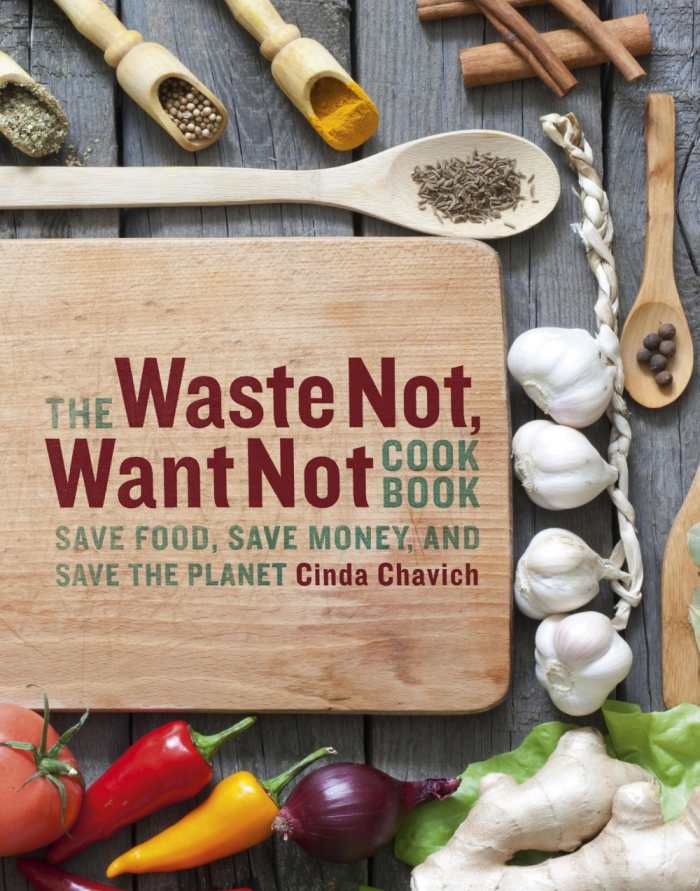
Cinda Chavich
TouchWood Editions
Softcover $24.95 (288pp)
978-1-77151-111-7
Buy: Local Bookstore (Bookshop), Amazon
If your parents didn’t raise you to believe that wasting food is sinful, Cinda Chavich is here to set you straight. The introduction to her The Waste Not, Want Not Cookbook lays out compelling environmental, economic, and philosophical reasons why we all need to do a better job of menu planning and upcycling our leftovers. From buying a smaller refrigerator to a weekly routine of cooking up bits and bobs from the larder, she has many useful, delicious ideas to waste less and eat more creatively.
The book’s format makes it easy to use based on what foods are on hand. It’s organized into three main categories—fruits and vegetables, staples, and weekly feasts (i.e., meat and fish)—so you can take stock of your pantry and quickly find cooking ideas, storage information, and recipes for related ingredients.
Do you have some apples hanging around? Whip up speedy Waldorf Salad. Got some leftover grilled steak, veggie, and the ubiquitous crop of fridge-door condiments? Oyster Sauce Beef Noodles fits the bill. Artsy food prints and photos also make the book graphically pleasing, so you just may find yourself reading the book through for pleasure as much as for its valuable information.
RACHEL JAGARESKI (May 27, 2015)
Sushi Specials
More than 50 Recipes for the Perfect Presentation
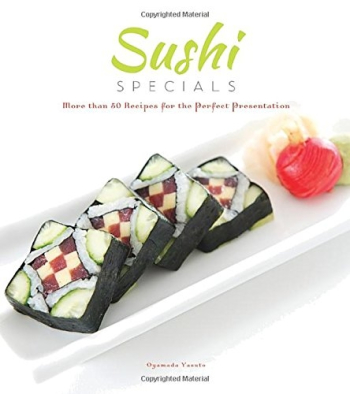
Oyamada Yasuto
Imagine! Publishing
Hardcover $15.95 (128pp)
978-1-62354-056-2
Buy: Local Bookstore (Bookshop), Amazon
Thirty years ago, most Americans hadn’t heard the word “sushi” and would never have considered eating raw fish—wrapped in seaweed, no less. Nowadays, you can hardly swing a mackerel without hitting a sushi restaurant in any urban neighborhood or suburban strip mall. Going out for sushi is getting to be as commonplace as grabbing a pizza, and it shows no signs of letting up.
In Sushi Specials, master sushi chef and restaurateur Oyamada Yasuto shares his expert technique so home cooks can recreate his jewel-like creations. With plenty of elegantly styled photographs, he discusses the necessary ingredients and offers recipes for basic building blocks, popular sushi and sashimi dishes, and his own “Japanese fusion” entrées.
While many cooks may never have the skills or gumption to attempt more than a simple plate of sashimi or sushi, readers will see more complicated presentations of such dazzlers as Crunchy Spicy Tuna or the Tuna and Egg Omelet Maki featured on the front cover with its exquisite mosaic design. The book is also useful for describing the various kinds of sushi—gunkan (nori boats topped with rice and soft ingredients), inari (fried tofu pockets filled with sushi items), and nigiri (rice ovals with fishy tops). Whether this book serves as a how-to cookbook or as a field guide to restaurant outings, Sushi Specials is an excellent choice for all sushi lovers.
RACHEL JAGARESKI (May 27, 2015)
Love Fed
Purely Decadent, Simply Raw, Plant-Based Desserts

Christina Ross
BenBella Books
Softcover $19.95 (238pp)
978-1-940363-32-5
Buy: Amazon
So you’re a raw-food devotee, a vegan, or maybe even a beegan (you make exceptions for honey), and fresh fruit just doesn’t strike you as the most indulgent finale to your special meals. Well, sweet toothers, don’t despair. In her Love Fed cookbook, Christina Ross reveals an extraordinary assortment of the most delectable raw desserts, from puddings and popsicles to pastries worthy of front-window placement in a Parisian bakery.
Ross created the Southern California vegan dessert line PatisseRaw and is a popular food blogger. Her cookbook contains all the information you need to assemble an enviable raw plant dessert pantry, from Irish moss to matcha powder. Next up is a chapter on how to make the sauces, creams, crusts, and butters that are the foundation of these beautiful confections. Then it’s off to the recipes for such succulent creations as Blueberry Coconut Dreamsicles, Boston Cream Cups, Banana-Toffee Pie, and Ross’s bestseller, Most Favored Raspberry Macadamia Cake.
RACHEL JAGARESKI (May 27, 2015)
The Café Spice Cookbook
84 Quick and Easy Indian Recipes for Everyday Meals
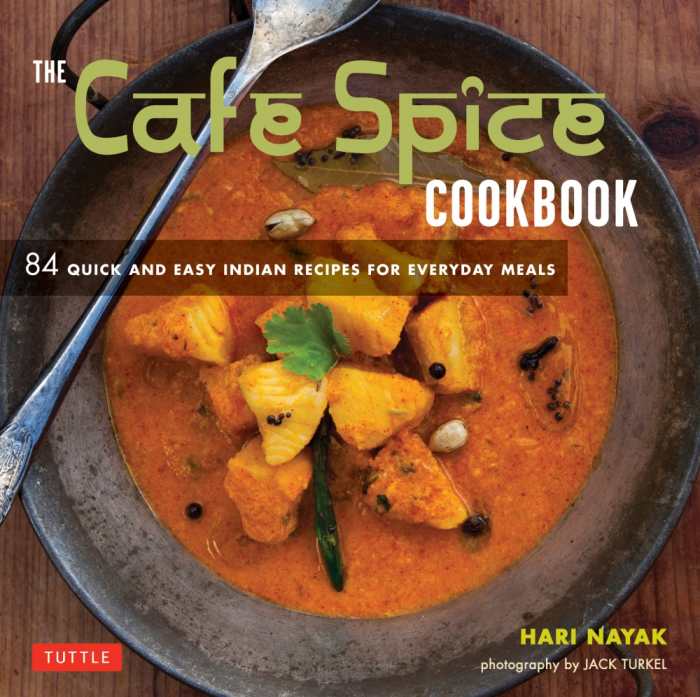
Hari Nayak
Jack Turkel, photographer
Tuttle Publishing
Softcover $14.95 (144pp)
978-0-8048-4430-7
Buy: Local Bookstore (Bookshop), Amazon
It wasn’t until Indian-born chef Hari Nayak arrived in New York that he had his first taste of Chicken Tikka Masala, yet this dish is the one many Westerners associate with Indian cuisine. While his version of this Anglo-Indian classic is included in The Café Spice Cookbook (and is the most popular menu item at his Café Spice restaurant), Nayak also introduces a heady variety of regional dishes. There are fish and seafood recipes from coastal Kerala, Steamed Yogurt Pudding inspired by traditional Bengali sweets, and chutneys, breads, soups, salads, and beverages from all over the Indian subcontinent.
Indian food is often a food photographer’s nightmare. It’s notoriously difficult to photograph well, consisting as it does of so many layers of spices and other small ingredients enveloped in brownish sauces. Photographer Jack Turkel is to be commended here for his technical prowess and evocative photos shot through with natural light and styled with rustic tableware and settings.
All of Nayak’s recipes are tailored for the American home cook. Armed with his short introduction to a few simple traditional Indian cooking techniques, ingredients, and preparation of basic spice blends, it is easy to replicate these tasty Indian dishes in short order.
Ready, set, naan.
RACHEL JAGARESKI (May 27, 2015)
The World’s Best Brunches
Where to Find Them and How to Make Them
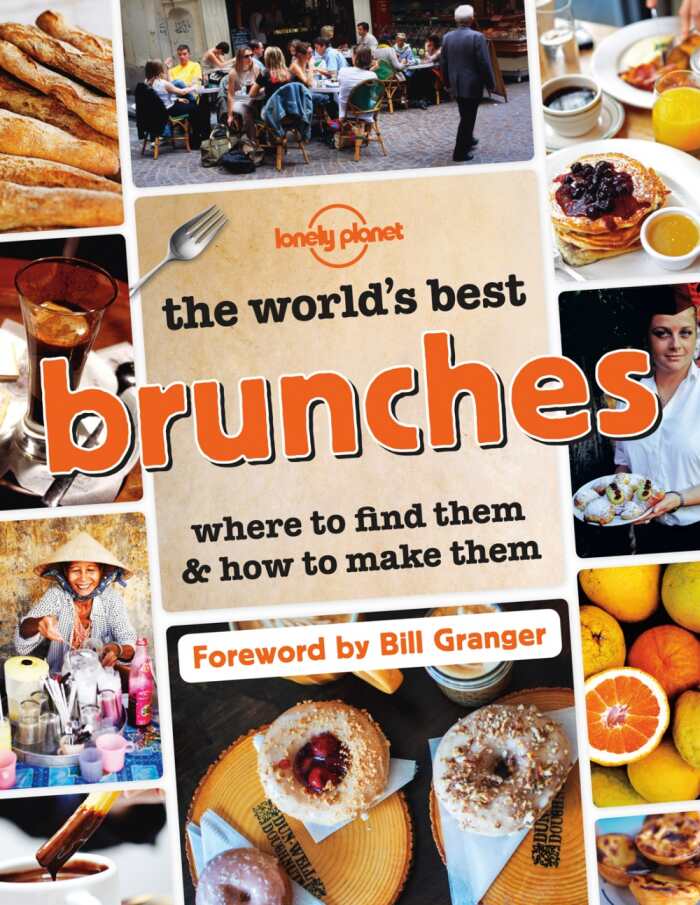
Lonely Planet
Lonely Planet Publications
Softcover $19.99 (224pp)
978-1-74360-746-6
Buy: Amazon
Brunch. Is any meal more luxurious? Caviar and truffles may be less appealing to most diners than a long, lazy meal with friends and cozy, homey food. In his foreword to The World’s Best Brunches, Aussie restaurateur Bill Granger describes brunch as a relaxing meal of “unfussy offerings” with “good, fresh ingredients put together in a simple, pleasing way—and coffee. Always coffee.”
Lonely Planet recognized that people the world over are crazy about this kind of leisurely feasting, so they devoted the third installment of their “The World’s Best” series to exploring brunch from many disparate cuisines. There are photographs and food lore for each of the 100 recipes (including advice on which restaurant or neighborhood serves the best version of each), and the recipes are coded to indicate ease of preparation, healthy or indulgent, vegetarian, and whether hands, chopsticks, or cutlery are involved.
The standards are all here, like the Full English Breakfast, Eggs Benedict, and Buttermilk Pancakes, but how about brunch in the Maldives? Or Turkey? Or Argentina? You can lean on Lonely Planet to find out.
RACHEL JAGARESKI (May 27, 2015)
400 Calories or Less with Our Best Bites
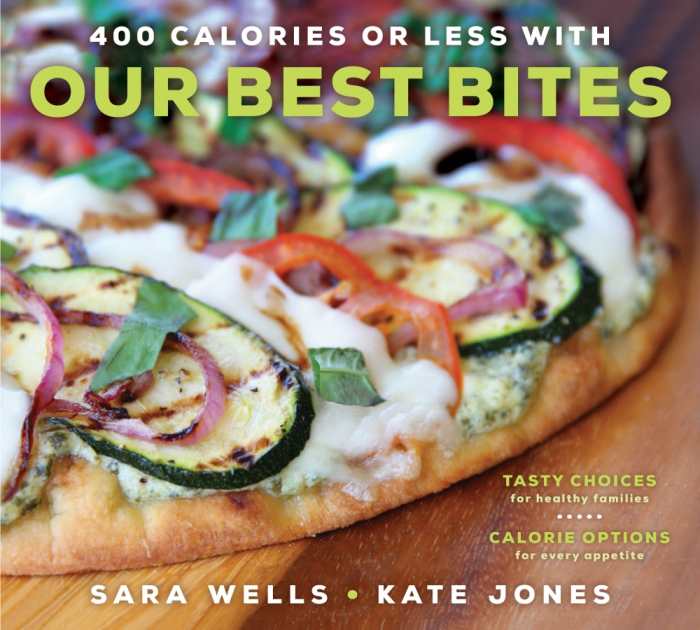
Sara Wells
Kate Jones
Shadow Mountain
Softcover $21.99 (180pp)
978-1-60907-991-8
Buy: Local Bookstore (Bookshop), Amazon
Body-conscious summer fashions and teeny-weeny swimsuits require mindful eating. The food-writing, recipe-developing duo of Sara Wells and Kate Jones are here to help with healthy recipes from their popular website and blog. In 400 Calories or Less with Our Best Bites, you will find over 65 recipes for such temptations as Roasted Asparagus and Mushroom Pasta in Lemon-Cream Sauce, Burrito Pie, and PB&J Ice Cream Cookie Sandwiches, all surprisingly 400 calories or less.
Wells and Jones offer a well-organized production, with nutritional breakdowns, full-page color shots, and easy-to-follow instructions. Each recipe’s “rollover ingredient,” a term coined by the authors for perishable or uncommon items, is linked to other recipes that can use it up. Another index organizes recipes by category (slow cooker, gluten-free, meatless, etc.).
This cookbook is perfect for breezing through the preparation of summer meals when cooks would rather be outdoors enjoying balmy evening breezes than sweating under pressure in the kitchen. While cooking and prep times aren’t stated, nearly all the featured recipes seem like they could be made in under an hour and don’t involve elaborate techniques. Healthy, easy, low-calorie recipes—what a splendid combination.
RACHEL JAGARESKI (May 27, 2015)
The Occidental Arts & Ecology Center Cookbook
Fresh-from-the-Garden Recipes for Gatherings Large and Small
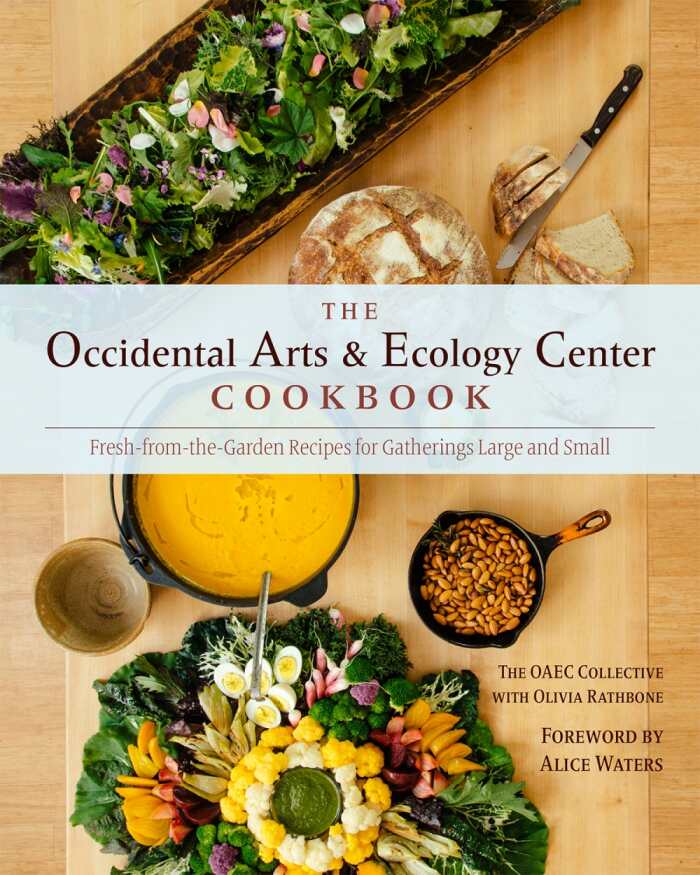
The OAEC Collective
Olivia Rathbone, contributor
Chelsea Green Publishing
Hardcover $40.00 (416pp)
978-1-60358-513-2
Buy: Amazon
The Occidental Arts and Ecology Center (formerly the Farallones Institute, and then the Center for Seven Generations) has been pioneering the American organic agriculture movement since the early 1970s. Set on eighty acres in California’s Sonoma County, it includes one of the first certified organic farms in the state and first agricultural easements in the country. When they are not farming or making art, OAEC members are teaching kids and adults about environmental issues or are engaged in eco-activism—the preservation of heritage seeds, for example, or advocacy against genetically modified crops.
These guys also know how to feast! The vegetarian recipes naturally showcase the enormous variety of vegetables, herbs, grains, and fruit which are grown in their gardens, including many unfamiliar plants like yacons, mangels, lovage, mitsuba, and a slew of wild edibles. There’s a recipe list preceding each of the four seasonal chapters and each has ingredients sized both for families and a crowd of thirty to forty persons.
Studded with gorgeous still-life food photos worthy of a Dutch Master, as well as many shots of OAEC members out in the gardens, this is a cookbook as delicious to peruse as it is to use.
RACHEL JAGARESKI (May 27, 2015)
Rachel Jagareski

